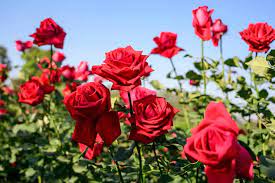**Cultivating Elegance: A Comprehensive Guide to Growing Roses**
Growing roses is a horticultural pursuit that blends the passion of an artist with the precision of a scientist. The allure of these timeless blooms, with their diverse colors, intoxicating fragrances, and symbolic significance, has made rose cultivation a beloved endeavor for generations. Whether you’re a seasoned gardener or a newcomer to the world of horticulture, mastering the art of growing roses requires an understanding of their unique needs and a commitment to providing the optimal environment for their flourishing.
**1. Choosing the Right Roses:**
The journey of how to grow roses begins with thoughtful selection. Roses come in various types, each with its own characteristics, growth habits, and bloom patterns. Hybrid Teas, Floribundas, Grandifloras, Climbers, and Shrub roses are among the popular categories. Consider your climate, available space, and aesthetic preferences when choosing the right roses for your garden. Researching and selecting disease-resistant varieties is crucial for a successful and sustainable rose garden.
**2. Selecting the Ideal Planting Site:**
Roses thrive in locations that receive ample sunlight, ideally six hours or more per day. Choose a well-drained site with fertile soil, ensuring good air circulation. Amending the soil with organic matter, such as compost or well-rotted manure, enhances fertility and promotes a healthy root environment. Proper drainage is essential to prevent waterlogging, a condition that can be detrimental to roses.
**3. Planting Your Roses:**
The act of planting sets the stage for a rose’s successful growth. Follow these steps for a successful planting:
– **Digging the Hole:** Dig a hole slightly larger than the root ball or container size, allowing the roots to spread comfortably.
– **Amending the Soil:** Mix the existing soil with compost or organic matter before backfilling around the plant. This provides essential nutrients and improves soil structure.
– **Placement:** Plant the rose at the appropriate depth, ensuring the graft union is at or slightly below ground level.
– **Watering:** Thoroughly water the newly planted rose to settle the soil and eliminate air pockets.
– **Spacing:** Provide adequate space between plants to facilitate good air circulation, reducing the risk of diseases.
**4. Watering Wisdom:**
Proper watering is crucial for the health of your roses. While roses appreciate consistent moisture, they are prone to issues if overwatered. Water deeply at the base of the plants, avoiding overhead irrigation that wets the foliage. Mulching around the base helps retain soil moisture and suppresses weeds. Adjust your watering frequency based on weather conditions, providing more during dry spells and less during periods of rain.
**5. Pruning for Health and Aesthetics:**
Pruning is both an art and a science in rose cultivation. Regular pruning promotes healthy growth, improves air circulation, and encourages abundant flowering. The timing and method of pruning depend on the type of rose:
– **Early Spring Pruning:** Typically performed in late winter or early spring before new growth begins. Remove dead, diseased, or crossing branches and shape the plant to the desired form.
– **Regular Deadheading:** Throughout the growing season, remove spent blooms to encourage continuous flowering.
**6. Fertilizing Your Roses:**
Roses are heavy feeders, and providing them with the right nutrients is essential for robust growth and prolific flowering. Fertilize in early spring as the roses begin to break dormancy and after the first bloom flush. Use a balanced fertilizer or specialized rose food, following package instructions. Organic options such as compost or well-rotted manure can also be beneficial.
**7. Pest and Disease Management:**
Vigilance is key to preventing and managing common rose pests and diseases. Regularly inspect your roses for signs of trouble:
– **Pests:** Aphids, spider mites, thrips, and caterpillars are common pests. Introduce beneficial insects like ladybugs, lacewings, and predatory beetles to control pest populations naturally.
– **Diseases:** Black spot, powdery mildew, and rust can affect roses. Consider using organic solutions like neem oil, insecticidal soaps, or horticultural oils for effective and eco-friendly control.
**8. Winterizing Your Roses:**
Preparing your roses for winter is essential, especially in colder climates. Follow these steps:
– **Stop Fertilizing:** Cease fertilization in late summer to allow the plants to harden off before winter.
– **Mulching:** Apply a layer of mulch around the base of each rose to insulate the roots and protect against temperature fluctuations.
– **Pruning:** In late fall or early winter, prune back long canes to prevent winter damage. Remove dead or diseased wood and any crossed or weak branches.
**9. Supporting Climbing Roses:**
For climbing roses, provide sturdy support structures such as trellises or arbors. Train the canes to encourage the desired growth pattern, and secure them gently to the structure. Regular pruning helps maintain the shape and coverage of climbing roses.
**10. Reveling in the Blooms:**
The culmination of your efforts is the magnificent blooms that grace your garden. Each blossom tells a story of care, attention, and the beauty of nature. Take the time to savor the colors, shapes, and fragrances your roses offer. Whether it’s the classic elegance of Hybrid Teas or the profuse clusters of Floribundas, each bloom adds its unique charm to your outdoor sanctuary.
**Conclusion:**
Growing roses is a journey that intertwines the gardener with the timeless beauty of nature. It’s an art of nurturing, a science of understanding, and a commitment to creating a space of elegance and tranquility. As you embark on the adventure of cultivating roses, remember that each step contributes to a tapestry of color, fragrance, and enduring grace in your garden. Embrace the process, learn from the seasons, and let the timeless beauty of roses enrich your horticultural experience.




